- info@wildlife-removal.com
Call us for help in your town
Wildlife Removal Education
Animal In The Attic
We are the nation's leading experts on removing animals from attics, so if you need help, you can hire us in one of our over 500 USA locations. Or you can read the below and do it yourself!
Several types of wild animals get inside the attics of homes and buildings. Most commonly, people become aware of the situation when they hear noises above the ceiling. The noises are usually some form of scampering around, scratching, digging, walking, thumping, or even vocal cries.
The type of noise you hear is actually a good clue in determining what type of animals you have living up there. Do you hear the noises in the daytime, or the middle of the night? Are the noises light and fast, or slow and heavy? Is it loud, or subtle? Does it come from everywhere, or
just one spot in the attic? I will analyze below each of the common wild animals that enter attics, and describe the types of sounds they make. I will also describe other clues that you may have noticed, such as the type of entry hole the animal used to enter your house, and the type
of evidence the animal leaves behind, in the form of droppings, tracks, and other signs. Finally, I'll analyze the time of year, so that you can best diagnose the animal that you know is up there, and address the problem properly. Let's get started!
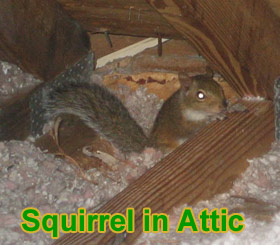 SQUIRRELS IN THE ATTIC:
I'll start with squirrels, which are the most common type of critter, nationwide, to invade attics. Although several species of squirrels will live in attics, the Eastern Gray Squirrel is the most common culprit. This is the squirrel seen to the left, the common one
with the fluffy tail.
SQUIRRELS IN THE ATTIC:
I'll start with squirrels, which are the most common type of critter, nationwide, to invade attics. Although several species of squirrels will live in attics, the Eastern Gray Squirrel is the most common culprit. This is the squirrel seen to the left, the common one
with the fluffy tail.
Squirrels are rodents, and expert chewers. They chew their way in, and once inside, they often chew the wood and the electrical wires (fire hazard!) They love to live in warm, dry attics, which are like a big hollow tree to a squirrel. Most commonly, a
squirrel in an attic is a mother squirrel who needs a safe place to give birth and raise her young. Once a squirrel lives in an attic, it'll return year after year to this safe haven, and create more damage each time.
For more information on squirrel control and removal, please see my full squirrel removal page.
TYPE & TIME OF NOISE: Squirrels are active during the daytime (diurnal). In fact, they're most active in early morning and evening, before sunset. So that's when you hear the noises. If you hear noises during any part of the day, especially morning and
evening, you've almost certainly got squirrels. The noise is usually a fast scamper, and not a heavy thumping. Sometimes you'll even hear them rolling nuts around! If it's just a mother squirrel, there's not much noise. But if there's four rambunctious juvenile squirrels up there, you'll hear a lot of noise! The noise can
come from any part of the attic, but squirrels do tend to stick near the entry hole, near the edge of the roof. They can also be heard in the walls, scurrying up and down.
HOW THEY GOT INSIDE: Squirrels can fit in a pretty small hole, of not much more than an inch and a half in diameter, but they usually chew the hole bigger for easy access. If you see a lot of chewing around the hole, it's likely squirrels. They always enter at roof level,
far off the ground. They can climb pretty much anything, so the entry hole can be anywhere, including the underside of the eaves. They'll take advantage of gaps in the architecture, if gaps exist. They usually have only one entry hole, and use the same hole over and over again.
EVIDENCE LEFT BEHIND: Squirrels leave hundreds of droppings in the attic, which look like fat little brown grains of rice. The droppings are usually about a third of an inch long each. They also leave nesting debris, such as leaves and sticks. They leave trails all throughout
the insulation, where they run around. They also chew on the wood and electrical wires.
TIME OF YEAR: Female squirrels give birth to two litters of young per year - the summer litter and the winter litter. The winter litter is born in late January, and the young are usually running around in March, which is when I get the most calls for squirrels in the attic. The
summer litter is born in early August, and the young run all over the place in September, the other high season for squirrels in the attic.
METHOD OF CONTROL: There are several control methods. First of all, absolutely no scent, such as mothballs or ammonia, will make them leave, nor will ultrasonic sound emitters or strobe lights. These tactics have been ruled fraudulent by the FTC, and they DO NOT WORK. You have to
remove the animals or they will never leave the attic. The best means is by trapping and relocating the squirrels. The other method is to use one-way exclusion doors that let them exit the attic, but not get back in. This latter method requires a chew-proof house (or they'll just chew
their way back in) and no access to other entry points. The entry holes all must be sealed once the squirrels are removed. Finally, it pays to inspect the attic for damage, such as wire damage, and the attic should be cleaned of droppings and parasites, to prevent the possible spread
of disease, and to get rid of the animal scent that can attract future animals into the home. For more advanced info, read squirrels in the attic guide.
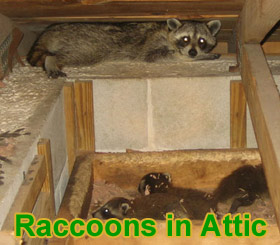 RACCOONS IN THE ATTIC:
Raccoons are another of the most common types of animal to enter attics. Raccoons are curious and
mischievous creatures, and they are also expert climbers, and very strong. Raccoons have become a common nuisance wildlife species nationwide, and they've learned to take
advantage of human influence - that means they eat out of our garbage cans and dumpsters, steal pet food, and often break into homes and attics for food and shelter. Like all wildlife, they seek out a warm, dry place in which to live. In particular, it's the female
raccoons, when they are ready to give birth to young, who really seek out a safe haven to have their babies. Thus, when you have a raccoon in your attic, it's most commonly a mother raccoon with a litter of babies. Raccoons are of course large animals, with adults
weighing up to 25 pounds (40 pounds up north), and they can cause tremendous damage in an attic!
RACCOONS IN THE ATTIC:
Raccoons are another of the most common types of animal to enter attics. Raccoons are curious and
mischievous creatures, and they are also expert climbers, and very strong. Raccoons have become a common nuisance wildlife species nationwide, and they've learned to take
advantage of human influence - that means they eat out of our garbage cans and dumpsters, steal pet food, and often break into homes and attics for food and shelter. Like all wildlife, they seek out a warm, dry place in which to live. In particular, it's the female
raccoons, when they are ready to give birth to young, who really seek out a safe haven to have their babies. Thus, when you have a raccoon in your attic, it's most commonly a mother raccoon with a litter of babies. Raccoons are of course large animals, with adults
weighing up to 25 pounds (40 pounds up north), and they can cause tremendous damage in an attic!
For more information on raccoon control and removal, please see my full raccoon removal page.
TYPE & TIME OF NOISE: Raccoons are active at nighttime (nocturnal). Thus, most of the noise you'll hear will be at night, often soon after sunset and soon before sunrise, as the animal exits and then re-enters the attic in its nightly foraging for food. They may also
be present any time of the night, and they can also sometimes be active during the day. Raccoons are large, so the noises will often be loud, and sound more like heavy walking than light scampering. Raccoons also make a variety of vocal noises, and the baby raccoons, in
particular, have a very distinct call. If you hear any vocal noises, such as chattering or growling, it's likely raccoons. For more info, I've written a guide to noises in the attic at night.
HOW THEY GOT INSIDE: Raccoons can climb just about anything and rip open just about anything. Their entry points are not subtle. They might tear a hole right through the shingles and roof, or they might rip out the soffit. They often take advantage of easy openings,
such as poorly screened vents or eave gaps.
EVIDENCE LEFT BEHIND: Raccoons are large, so they leave behind large evidence. This includes large tracks and pathways through the insulation, and large droppings, like that of a small dog. The droppings often contain berries. They also leave a lot of destruction,
so if you see ducts torn to shreds, for example, it's probably raccoons.
TIME OF YEAR: Raccoons might live in an attic at any time of year, but it's most common for a female raccoon bearing young to enter the attic. Thus, it's most common to get a raccoon in the attic during the springtime, with March and April as the peak season for entry.
However, once the mother raccoon is living in the attic with her young, she and the young will stay for up to 8 months as she raises them. Then she kicks them out of the territory and lives in your attic again for the next litter. Raccoons in the southern US can have young at
any time of year, but up north, it's usually in the spring.
METHOD OF CONTROL: First of all, mothballs or ammonia won't make them leave, nor will ultrasonic sound emitters or strobe lights. These tactics have been ruled fraudulent by the FTC, and they DO NOT WORK.
However, female raccoons will sometimes respond to the scent of a male raccoon, a threat to her babies. You have to
remove the animals or they will never leave the attic. The best means is by trapping and relocating the raccoons. The attic must be searched for the baby raccoons, or you could end up with a big problem on your hands - starving, squealing babies, which will die and rot and
stink if they're not removed. The entry holes all must be sealed once the raccoons are removed, and sealed well, bolted down with steel.. Finally, it pays to inspect the attic for damage, such as wire damage, and the attic should be cleaned of droppings and parasites, to prevent the possible spread
of disease, and to get rid of the scent that can attract future animals into the home. For more advanced info, read raccoons in the attic guide.
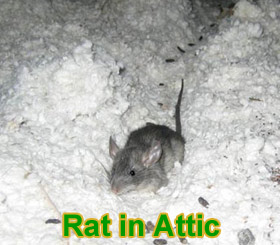 RATS AND MICE IN THE ATTIC:
The most common critter to enter attics in many areas, including where I work, in Florida, is the rat. There are two main species of rats in the US, the Roof Rat and the Norway Rat. The Roof Rat is more common in warm areas, and more likely to enter the attic. Norway Rats
tend to stick to the ground and the sewers and basements, in their stomping grounds up north. House Mice live everywhere, and they also commonly go inside attics. Rats and mice are commensal rodents, which means that they associate themselves with people, not the wild. They
are more common in cities than in the country. As such, they most commonly live inside buildings, and since they don't like to be seen, they mostly live in the walls and inside the attic. They are active year-round, and they can breed in very high numbers. Thus, rats
in the attic can quickly get out of hand if not properly addressed.
RATS AND MICE IN THE ATTIC:
The most common critter to enter attics in many areas, including where I work, in Florida, is the rat. There are two main species of rats in the US, the Roof Rat and the Norway Rat. The Roof Rat is more common in warm areas, and more likely to enter the attic. Norway Rats
tend to stick to the ground and the sewers and basements, in their stomping grounds up north. House Mice live everywhere, and they also commonly go inside attics. Rats and mice are commensal rodents, which means that they associate themselves with people, not the wild. They
are more common in cities than in the country. As such, they most commonly live inside buildings, and since they don't like to be seen, they mostly live in the walls and inside the attic. They are active year-round, and they can breed in very high numbers. Thus, rats
in the attic can quickly get out of hand if not properly addressed.
For more information on rat and mouse control and removal, please see my full rat
and mouse removal page.
TYPE & TIME OF NOISE: Light scurrying noise at night, anywhere in the attic or walls. Not much else to say. They sometimes sound very fast. If the acoustics are right, they can sound much bigger than they are.
HOW THEY GOT INSIDE: Rats can climb pretty much any surface. They can get wherever they want to go. They can squeeze through amazingly small holes and gaps. They can get in through the sewer pipes or any possible gap or hole in a home, from the
foundation to the tip of the roof.
They can also chew. If a rat detects just a small breeze coming from inside, they'll get in.
EVIDENCE LEFT BEHIND: Rats leave a ton of droppings, sometimes tens of thousands of droppings in an attic - they look like 1/3 inch brown thick grains of rice, very similar to squirrel droppings. They also leave tunnels and trailways in the insulation. They also leave chew
marks, and interestingly, they leave brown smudges from grease in their fur, and this lines the commonly travelled rat routes.
TIME OF YEAR: 24/7/365. However, rats are especially aggressive about getting inside a warm attic during a cold winter.
METHOD OF CONTROL: First of all, mothballs or ammonia won't make them leave, nor will ultrasonic sound emitters or strobe lights. These tactics have been ruled fraudulent by the FTC, and they DO NOT WORK. POISON IS A HORRIBLE IDEA FOR MANY MANY REASONS - poison won't solve
the problem, and it'll just create more problems. The only way to solve a rat or mouse problem is to find every last point of entry into the house, and seal it shut. Then the rats should be trapped and removed. Snap traps are actually the very best way to do it.
For more advanced info, read rats in the attic guide.
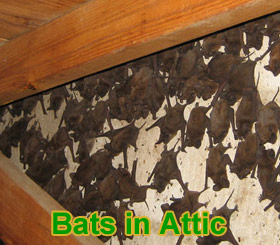 BATS THE ATTIC:
Ah, bats in the attic. This is one of the more serious and complicated problems in the field of nuisance wildlife control. Bat colonies want to roost in a safe place - a cave, for example. But the attic of a home will do quite nicely. The colonies of bats are usually composed
entirely of female bats, and are called a maternity colony. The female bats usually give birth to one baby bat each summer. Thus, the colony size roughly doubles at birth, and when the baby bats start to fly, you notice twice as many bats. Bats live a very long time, and
they stay in the same place year-round, conditions permitting, or they migrate and return each summer. Thus, with time, bat colonies can grow to enormous sizes.
A fully infested bat attic is one of the biggest and most challenging problems
in the field of problem wildlife removal.
BATS THE ATTIC:
Ah, bats in the attic. This is one of the more serious and complicated problems in the field of nuisance wildlife control. Bat colonies want to roost in a safe place - a cave, for example. But the attic of a home will do quite nicely. The colonies of bats are usually composed
entirely of female bats, and are called a maternity colony. The female bats usually give birth to one baby bat each summer. Thus, the colony size roughly doubles at birth, and when the baby bats start to fly, you notice twice as many bats. Bats live a very long time, and
they stay in the same place year-round, conditions permitting, or they migrate and return each summer. Thus, with time, bat colonies can grow to enormous sizes.
A fully infested bat attic is one of the biggest and most challenging problems
in the field of problem wildlife removal.
For more information on bat colony control and removal, please see my full bat removal page.
TYPE & TIME OF NOISE: Bats are nocturnal, but they are pretty quiet in small numbers, and most people don't notice any noise. However, a large swarm of thousands of bats makes a hell of a ruckus, what with the crawling and flying and squeaking of the whole bunch.
HOW THEY GOT INSIDE: Bats can squeeze through extremely small gaps - 3/8 of an inch. They like to fly into homes at small architectural gaps near the edge of the roofline, usually. From there, they crawl to their roosting spots.
EVIDENCE LEFT BEHIND: Although physical sightings of them entering and exiting the building are the best
identifier, bats clearly make themselves known with the odor of their droppings, or guano. It can accumulate in huge amounts, contaminating an
attic and potentially causing lung disease for the people in the house.
TIME OF YEAR: If the attic is warm enough, year round. Otherwise, they migrate and return each spring. Many bat problems happen when the young start to crawl around and fly, and sometimes the inexperienced young crawl down into the house. This usually
happens in the month of August, which is the high season for bat control work.
METHOD OF CONTROL: Mothballs or ammonia won't make them leave, nor will ultrasonic sound emitters or strobe lights. These tactics have been ruled fraudulent by the FTC, and they DO NOT WORK. The bats must be removed from the attic, and they are protected as colonies,
so they must not be killed. You don't want to kill a beneficial bat anyway. The bats are usually excluded through one-way exclusion devices. Sealing the building properly is critical to the process.
For more advanced info, read bats in the attic guide.
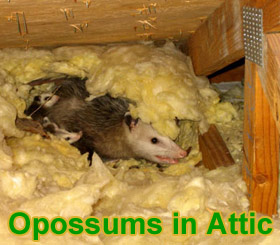 OPOSSUM THE ATTIC:
Many people don't believe me when I say that I remove opossums from attics. Well, I do, and I remove a LOT! Opossums are great climbers, with their opposable thumbs, and they like to live in a warm, dry, safe attic as much as the next critter. And as usual, female opossums
seek out a safe place to have their young, by instinct, so an opossum in an attic is usually a female with young. Luckily with opossums, the young cling to her 24-7, so it's easy to remove them all, without searching for a separate nest of baby animals. Opposums will also
exhibit a unique behavior of denning up in adult groups during the winter. I've seen up to six adult opossums living together in one attic during winter. It's unusual, because possums are not normally social animals. Once opossums get into an attic, they leave a huge mess
with their dog-sized turds, and they also frequently die in attics. The stench has to be smelled to be believed.
OPOSSUM THE ATTIC:
Many people don't believe me when I say that I remove opossums from attics. Well, I do, and I remove a LOT! Opossums are great climbers, with their opposable thumbs, and they like to live in a warm, dry, safe attic as much as the next critter. And as usual, female opossums
seek out a safe place to have their young, by instinct, so an opossum in an attic is usually a female with young. Luckily with opossums, the young cling to her 24-7, so it's easy to remove them all, without searching for a separate nest of baby animals. Opposums will also
exhibit a unique behavior of denning up in adult groups during the winter. I've seen up to six adult opossums living together in one attic during winter. It's unusual, because possums are not normally social animals. Once opossums get into an attic, they leave a huge mess
with their dog-sized turds, and they also frequently die in attics. The stench has to be smelled to be believed.
For more information on opossum control and removal, please see my full opossum removal page.
TYPE & TIME OF NOISE: Opossums are nocturnal. They are pretty slow, and they usually sound like a ...slow, heavy animal walking through the attic. They are actually pretty quiet.
HOW THEY GOT INSIDE: Possums usually just climb up the house and enter an easy opening, like an uncovered soffit vent or open eave gap. They don't really force their way in. But they do need a relatively large opening.
EVIDENCE LEFT BEHIND: A ton of shit, basically! Opossums make huge turds, and lots of them, and they leave them all over the attic. The terds are easy to identify, since they're large with often pointed tips. They also leave the usual trails
in the insulation. The young also frequently fall down walls and scratch and such if that happens. Mostly, people notice the smell of opossums, either living (tolerable odor) or dead (intolerable odor).
TIME OF YEAR: Mostly in May and June, as mothers enter an attic to keep their young safe, and again in December & January, to keep warm during the coldest winter months.
METHOD OF CONTROL: Mothballs or ammonia won't make them leave, nor will ultrasonic sound emitters or strobe lights. These tactics have been ruled fraudulent by the FTC, and they DO NOT WORK. Opossums are easy to trap, either outside OR INSIDE the attic (inside
trapping usually does not work on most critters), and the entry holes have to be sealed. If you want to know how to get rid of animals in the attic, this is the correct method - trapping, removal, and sealing of entry points. Not too hard, with possums.
For more advanced info, read opossums in the attic guide.
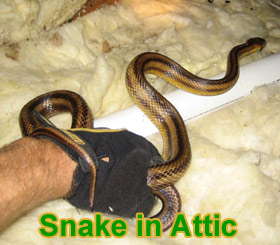 SNAKE THE ATTIC:
Yes, snakes actually do sometimes live in attics. The snakes that do so are of course climbing snakes, such as this Yellow Rat Snake that I caught out of an attic.
These snakes aren't venomous, but many people don't like the idea of snakes
living in their attic.And baby snakes, if born in the attic, will get
everywhere!
SNAKE THE ATTIC:
Yes, snakes actually do sometimes live in attics. The snakes that do so are of course climbing snakes, such as this Yellow Rat Snake that I caught out of an attic.
These snakes aren't venomous, but many people don't like the idea of snakes
living in their attic.And baby snakes, if born in the attic, will get
everywhere!
In every case I've ever seen involving snakes in an attic, there were also rodents in the attic - usually rats.
Rats leave a very distinct odor, and snakes simply follow the rat trails up into the attic, in order to catch prey. As long as there's food, the snakes live up there. And snakes can fit into tiny spots, so they can follow any area a rat can go. Of course, one of the best
ways to solve a problem with snakes in the attic is to solve the rodent problem first.
For more information on snake control and removal, please see my full snake removal page.
TYPE & TIME OF NOISE: I've actually had a few customers describe "slithering" noises in the attic, and lo and behold, they did have snakes up there. I've never heard it personally, so I don't know what to say.
HOW THEY GOT INSIDE: The snakes in attics are usually rat snakes, good at climbing, and they can of course fit in very tiny holes, from the ground up.
EVIDENCE LEFT BEHIND: Snake skins, of course, and I've seen attics with several shed skins.
TIME OF YEAR: Any time of year, although snakes tend to be more active in warmer weather.
METHOD OF CONTROL: Mothballs or ammonia won't make them leave, nor will ultrasonic sound emitters or strobe lights. The best bet is actually to solve the rat problem and get rid of the smell that's attracting the snakes in the first place. And of course, seal shut
any areas that either rats or snakes can use to enter the home. Snake traps also work well inside attics. For more advanced info, read snakes in the attic guide.
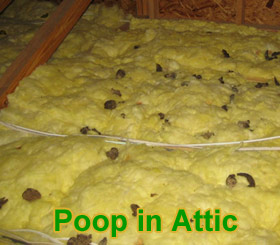 ANIMAL POOP IN THE ATTIC:
One of the largest problems with having animals live in your attic is that they poop and pee in your attic. Every animal does it of course, and many of them will turn your attic into a regular sewer. The pee tends to soak in the insulation, whereas the poop sits there.
ANIMAL POOP IN THE ATTIC:
One of the largest problems with having animals live in your attic is that they poop and pee in your attic. Every animal does it of course, and many of them will turn your attic into a regular sewer. The pee tends to soak in the insulation, whereas the poop sits there.
The droppings or many animals contain pathogens and cause diseases that humans can contract. Raccoon droppings, for example, contain the deadly-to-humans raccoon roundworm. Bat and bird droppings can grow the histoplasmosis spores that cause lung infection. Rat poop,
I think there's at least a dozen major diseases associated with.
It's important to clean up the animal waste, for sanitary and health purposes,
and because the scent can attract new animals into your attic. Learn to identify - opossum poop -
rat poop -
squirrel poop -
raccoon poop.
For more information on attic cleanup, please see my full attic restoration page.
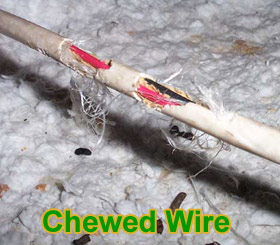 WIRE CHEWING IN THE ATTIC:
Animals can cause a lot of damage when they live in your home or attic. Some of the damage isn't such a big deal - such as gnawing on wooden beams or scratching off the insulation or insulating paper. Some damage is more serious, such as destruction of
vents or ductwork, which can cause lost air conditioning or heating. And some damage is even more serious, such as when rodents gnaw on PVC pipes, which can cause water leaks, or even worse, gnaw on electrical wires. Gnawed-upon wires might short out,
causing a power outage in the home. I've also been to several homes in which animals set off home security systems by chewing on wires. But the biggest threat is the fire hazard caused by electrical wires. Oftentimes the wires lay against wood or other
flammable materials, and the rodents chew past the insulating coating and down to the copper core, and the heat from the wire against the wood can cause the house to catch on fire and burn down. So it's important, for this reason, and many others, to
get rid of animals in the attic.
WIRE CHEWING IN THE ATTIC:
Animals can cause a lot of damage when they live in your home or attic. Some of the damage isn't such a big deal - such as gnawing on wooden beams or scratching off the insulation or insulating paper. Some damage is more serious, such as destruction of
vents or ductwork, which can cause lost air conditioning or heating. And some damage is even more serious, such as when rodents gnaw on PVC pipes, which can cause water leaks, or even worse, gnaw on electrical wires. Gnawed-upon wires might short out,
causing a power outage in the home. I've also been to several homes in which animals set off home security systems by chewing on wires. But the biggest threat is the fire hazard caused by electrical wires. Oftentimes the wires lay against wood or other
flammable materials, and the rodents chew past the insulating coating and down to the copper core, and the heat from the wire against the wood can cause the house to catch on fire and burn down. So it's important, for this reason, and many others, to
get rid of animals in the attic.
I hope I've done a good job of showing you how to identify what type of critter problem you have, and how to remove animals in the attic. For the most part, it is not a simple solution. You can't go out to Wal-Mart and buy "rodent-be-gone" and sprinkle it
around and expect your animal problem to go away. The animals must be removed properly, via trapping or exclusion, and the entry points leading into the building and attic must be identified and properly sealed, and the waste really ought to be cleaned up
and the damage in the attic repaired. Remember, the repairs are the most crucial part of the process for getting rid of animals in the attic. Learn how are animals getting inside your house here.
I highly recommend that you hire a professional wildlife control expert with experience in dealing with animals in homes and
buildings if you have a problem with critters in the attic.
How to Remove a Wild Animal in the attic
There are many different methods you could take when it comes to removing a wild animal from the attic. For the most part, you'll want to tailor your method to suit the animal that you're trying to remove. A bat can't be dealt with in the same way as a rat or a mouse, for example. Before you take any nuisance wildlife removal action, you must be first be certain of three things: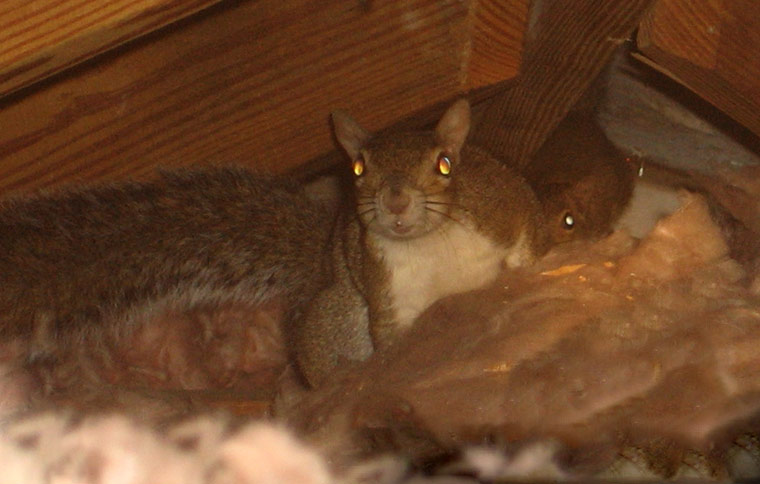
1 - That the animal is alone.
2 - That the animal is not trapped or injured.
3 - What species the animal is.
If you can't be sure that the animal isn't alone, you run the risk of sealing them inside your home or building. Very often a mother wild animal has moved in with a nest of young. Your home, particularly your attic, provides these creatures with everything they need in order to stay safe and thrive. There is food close, a source of fresh water, and there is also warmth and protection from predators. Those are all things that thee animal need and there are very few places to find it ‘out in the wild'. Attics have taken over as one of the common places for these animals to live, but once upon a time it would have been hollowed-out trees in the wild.
If you remove one wild animal, trapping the rest of the colony or a family inside your home, they will either die or cause new patches of damage as they try to break out. Youngsters inside a nest will die because they don't have their mothers to take care of them. After a while, you will need to find the source of the bad stench that is coming from somewhere deep in your home, and because the animals are now dead, it'll be much, much harder for you to find them.
If the animal is trapped, injured or sick, you will need to take a different approach to removing it. The slightest touch from you will cause a great deal of pain for a much smaller animal that is suffering from an injury, and could also result in death.
At the same time, however, YOUR safety is important. Many wild animals carry with them a string of diseases, and just one of those diseases is rabies. In the USA, the most common transmitters of the rabies infection are skunks, foxes, raccoons, coyotes and bats. Rabies also can spread into domesticated animals when they have not been vaccinated from a young age, and these include not just cattle, but household cats and dogs, alongside strays too. This is why it is very dangerous to get too close to s tray animal. You should also bear in mind that the animal could be feral. There are rumored to be a great number of feral cats in the USA.
You will also need to know what animal you're actually coming up against. This will give you the greatest ammunition when it comes to fighting back against nuisance wildlife. When you know what species you have, you can further educate yourself on how to deal with the problem. Rats and mice can be trapped using conventional snap traps, which are designed to kill them on impact. Sadly, as much as you might want to trap and release these rodents, it is often not safe to do so. They are disease-ridden, and they can also carry parasites, such as fleas, ticks and mites, which can be passed onto your household pets and infest your home.
Larger animals, such as raccoons and opossums, should be dealt with by a professional and licensed nuisance wildlife control technician. Alongside the problem with rabies and other diseases, the feces and urine, as well as other biological material, can often be very dangerous to humans, spreading diseases such as salmonellosis, leptospirosis, and even the plague.
When you come to an animal such as the bat, the need to hire a professional is even greater. Three species out of the twenty you'll find across North American are protected, and you WILL need to ensure you're not homing one of more of these species. It is illegal to kill bats in almost all States too, and this can often happen by accident by using incorrect trapping techniques. At the same time, rats have been known to fly hundreds of miles from one summer spot to another winter one, and this means that relocating them elsewhere is not the best option. All of that side, with bats especially, removing them from your local area could provide detrimental. A colony of bats will eat thousands of mosquitos and other bugs, and if they don't, the bugs are left flying around and annoying you.
In the case of bats in the chimney, live exclusion methods are the only successful methods. You could also consider buying and installing a roosting / home box for the bats at the bottom of the garden instead.






































